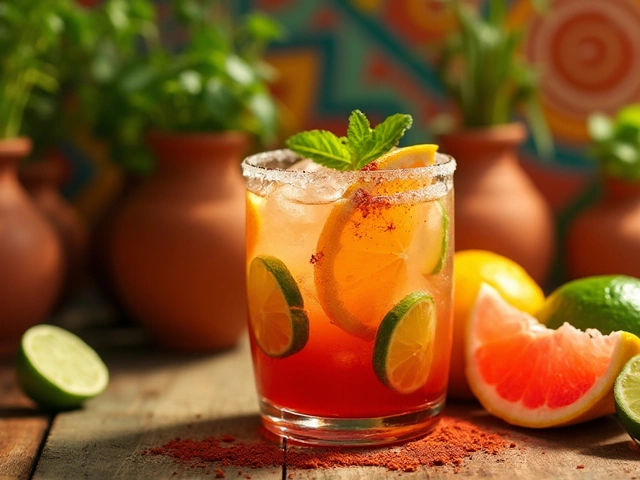
Picture this: you’ve got a chilled bottle of Pinot Grigio sweating on the table, glasses clinking, and everyone waiting to see what you’ll serve. Pinot Grigio isn’t just a wine; it's like the background melody that makes a meal sing. But not every dish plays well with this Italian favorite. Get it right, and magic happens. Get it wrong, and your dinner turns into a forgettable tune. Craving that perfect sip-and-bite harmony? Here’s how to make Pinot Grigio the highlight of your table.
The Personality of Pinot Grigio: Light, Crisp, and Versatile
Pinot Grigio, which is called Pinot Gris in France, has built its fan club around being refreshingly crisp and almost impossibly easy to drink. Think green apple, lemon zest, pear, and sometimes a whiff of honeysuckle or almond. It’s a wine that doesn’t shout for attention, but slips in with that politely tart, zesty charm. The most famous Pinot Grigios come from northern Italy, especially the Veneto, Friuli, and Alto Adige regions, where the cool climate keeps the fruit bright and acidity high.
What sets Pinot Grigio apart is its clean profile. No oak, no syrupy sweetness (for the dry styles), just a clear, zippy white ready to play second fiddle to your food. Unlike heavy Chardonnays that muscle their way onto your palate, Pinot Grigio stays polite and fresh. It usually lands between 12% and 13% ABV, making it almost sessionable for a wine. According to stats from the International Organisation of Vine and Wine, Pinot Grigio is one of the top-selling white wines globally, with the US and UK loving it the most.
One cool fact: in the 1970s, sales of Pinot Grigio exploded in the US as drinkers looked for something lighter than oaky Chards and not as sweet as Riesling. Today, it’s a restaurant standby, especially on sun-soaked patios and at relaxed lunches. If you’re thinking of wines that travel well from seafood platters to salads, this is your buddy.
But what if you get a Pinot Gris from Alsace? It’s richer, a little oilier, sometimes with a faint hint of smoke. So always check the label—you might need heartier food to keep pace with these versions. As a baseline, though, most Pinot Grigio is food’s best friend.
Pairing Success: What Flavors Work Best with Pinot Grigio?
This wine lives for light, fresh, and simple flavors, which means you don’t have to break the bank or sweat over complicated recipes. Here’s where it gets really interesting: Pinot Grigio is almost tailor-made for seafood. Picture grilled prawns, lemony calamari, or a simple white fish in herby olive oil. The wine’s acidity slices through oily textures and makes each bite brighter. A quick stat? A 2022 survey of 500 sommeliers by Wine & Spirits magazine ranked Pinot Grigio as the number one white for pairing with shellfish—beating out even Sauvignon Blanc.
Salads, especially those with citrus dressings or apples, are also a bullseye. The wine’s crispness stands up to vinaigrettes, which tend to be a nightmare for flabbier whites. Ever had trouble pairing wine with salad? Try a sip of Pinot Grigio—it works with leafy greens, goat cheese, or even a classic Niçoise.
Think picnic food or Italian antipasti. Prosciutto, melon, mild hard cheeses like Asiago or Manchego, and even herby chicken skewers make simple, brilliant matches. The key is to avoid heavyweight dishes. Pinot Grigio can’t compete with smoky barbecued meats, creamy tomato pastas, or spicy curries—it just gets lost.
If you want to dial up the pairing, try Asian fare like Vietnamese summer rolls or sushi—nothing too spicy. The clean, stone-fruit notes actually bring out the sweetness in fresh prawns and crab. Ever had it with ceviche? That’s a party in a glass. Just go light on the chili and let the acidity do its work. Some creative bartenders even use Pinot Grigio as a base for white wine spritzers with cucumber or basil, giving a fresh twist to summer appetizers.
| Dish | Why it works |
|---|---|
| Grilled shrimp with lemon | Cuts through the shellfish richness |
| Caprese salad | Matches the acidity of tomatoes & balsamic |
| Prosciutto & melon | Fruitiness complements salty, sweet bites |
| Light pasta with pesto | Herbs and acid play nicely with light wine |
| Chicken lettuce wraps | Handles herbs & crunch without overpowering |
| Goat cheese tart | Brightens creamy cheese and light pastry |
| White fish ceviche | Lemon notes echo citrus marinade |
| Sushi (especially maki) | Clean flavors, low spice are a win |

Cheese and Pinot Grigio: From Mild to Marvelous
The cheese board can be a minefield for wine pairing—some cheeses bulldoze delicate whites, others make reds taste bitter. With Pinot Grigio, you want to stay clear of the blue cheeses and very aged, funky options. Instead, look for young, soft, or semi-soft cheese styles. Goat cheese is a classic, bringing out zippy citrus notes in the wine. Fresh mozzarella (think Caprese salad), ricotta, or even burrata? Heavenly.
If you want a little more weight, creamy cheeses like Camembert or Brie are surprisingly good, especially if you let the cheese come to room temperature and drizzle with a bit of honey or fresh herbs. Mild cow’s milk cheeses like Havarti, Emmental, or Swiss keep the pairing relaxed and friendly. Heading to hard cheeses, Manchego or Asiago (nothing too aged) keep things in balance. Stay away from heavy blues or pungent washed rinds, as their power will leave Pinot Grigio tasting watery.
Want to level up your cheese plate? Add almonds, green apples, or roasted grapes. The textural contrast will make both the wine and cheese sparkle. One trick sommeliers swear by: try Pinot Grigio with a herbed cheese spread on crostini—especially if you’re serving outdoors in summer. The wine is almost always chilled, so let the cheese warm up to avoid muting flavors. And if you’re prepping charcuterie, add cured meats like prosciutto or mortadella, steering clear of spicy salamis that can numb the subtle notes in your glass.
Fun cheese fact: Wine Spectator’s 2023 guide found that Pinot Grigio was the top recommendation for cheese plates at music festivals and outdoor events in Northern Italy—mainly because nothing is too heavy and everything tastes cleaner with a splash of this white.
Pinot Grigio on the Table: Unfussy, Flavorful Entertaining
The best thing about Pinot Grigio is how it fits into nearly any meal without a fuss—there’s no need for candlelit drama or hours of decanting. This is the wine you grab for casual get-togethers, picnics, or that first warm-night dinner outside on your balcony. Its crispness and bright fruit flavors don’t get bogged down by sides or mixed plates. Serving a Mediterranean spread with olives, roasted veggies, and pita? Pinot Grigio keeps the palate refreshed.
If you’re wondering about room temperature versus chilled, Pinot Grigio loves to be served cold—between 8 to 10°C (that’s 46 to 50°F). Pull it out of the fridge fifteen minutes before you’re ready to pour, and the flavors will have a chance to open up. Too cold, and you’ll lose the aromas; too warm, and it starts to feel a bit flabby. And don’t worry about fancy stemware—any tulip-shaped glass will do the trick.
Another pairing hack? Mix up textures. If your food is crunchy or raw, like fennel salad or snap peas, Pinot Grigio fits right in. If it’s soft and creamy—say, a seafood risotto with Parmesan—watch how the wine tames each bite, leaving your palate clean and ready for more. Just keep things light. Heavy sauces and scorching heat (like hot Szechuan dishes) can steamroll the gentle flavors here.
Curious about desserts? Skip the super-sweet stuff and try Pinot Grigio with fresh berries, poached pears, or an almond biscotti. The wine’s subtle flavors won’t fight for attention, and the acidity keeps things lively. People are also experimenting with Pinot Grigio in cocktails—think Italian spritzes—paired alongside nibbles like marinated artichokes or grilled zucchini.
Want a breakdown of which regional styles to grab for different pairings? Italian Pinot Grigio is the most flexible, while Oregon and New Zealand versions are fruitier, so they stand up to slightly more robust food (like lightly spiced Thai or Asian chicken dishes). Alsace Pinot Gris is richer—think roast poultry with apples or root veg. The grape adapts, but the rules stay simple: aim for light, bright, and fresh, and you’ll never go wrong.





Categories